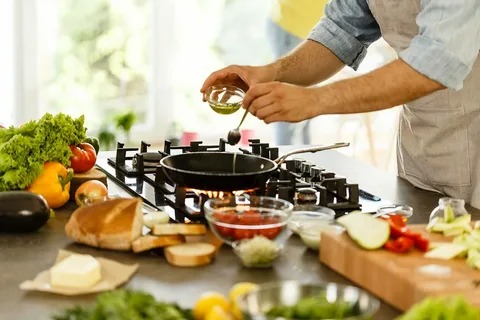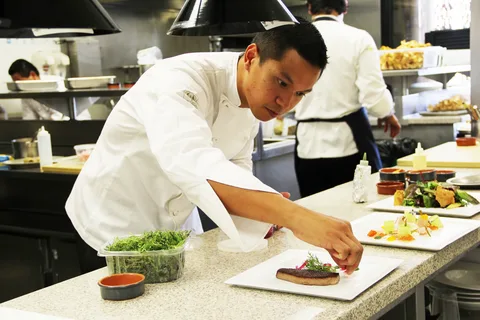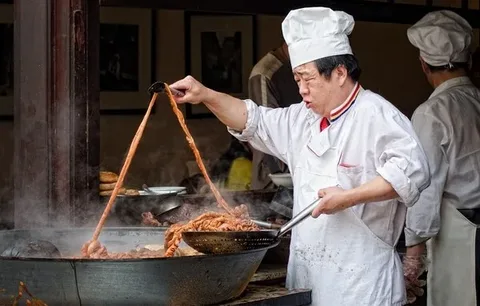Introduction
It’s distinctive, delicious and perhaps one of the most popular food styles in the world, Chinese cuisine being characterized by its vegetables – meat – noodles – rice dishes. But the normal Chinese dishes can consume a large amount of oil, energy and non-recyclable containers for take out trays which are not very environmental friendly. The good news here is that it is rather simple to tweak what you are using in any standard Chinese dish so that it will be less unhealthy for you while still having that homemade taste that makes it so lovely. Here, I list the advice that will help anyone cook home-style Chinese food with an earth-friendly perspective.

Use Less Oil and Meat
Most of the Chinese foods are cooked in stir-frying and deep-frying hence requiring huge quantities of oil. Suggest the usage of non-stick cookware in order to minimize the portions containing oil or try putting vegetable broth or water half the quantity of oil. If a recipe specifies deep fry, try pan- fried, baked or roasted which requires less oil.
Of course, you can also reduce the portions of meat consumed while still making the dishes delicious. Savor more vegetable meals such as Buddha’s Delight, which has a lot of good stuff, mainly vegetables. If you do, select the healthy meat and make sure to balance your serving portions in the right way by serving controlled proportions. Meatless once a week does help.
Eaten and incorporate with More Vegetables and Tofu
Increase portion size of vegetables in, home style Chinese copy while decreasing portion size of meat. Chinese broccoli, bok choy, mushrooms, bean sprouts, snow peas and any other delicious vegetable you can think of are the mainstays of Chinese foods.
Tofu it is also an excellent source of protein that is used as a meat substitute as it absorbs the marinade and flavors after stir-frying. It gives protein that is as complete as animal protein but without almost the same effect on the environment as animal protein production. Cooking more Chinese vegetable and tofu dishes at home to make greener your meatless meals.

Ensure to cook in batches and any leftovers should be frozen.
Preparing foods in large quantities is economical than preparing several meals at a time. When stria fry rice, noodles, and protein double the portion and store the remaining in the refrigerator or freezer. Whiling leftovers frozen make easy working lunches also.
That prepared ingredients keep on standby also assists in lessening the amount of cooking time hence the energy spent is less. Deep fry rice with vegetables and fry eggs in a double quantity. Scatter part of it and more rice can just be microwaved to defrost when needed rather than continually stir-fry.
Fare Food: Grow Your Own Scallions and Sprouts
One can actually grow firm scallions and bean sprouts at home which reduces farm to store transport. Local foods fed in homes are also fresh products that do not contain packaging and preservatives as well. Eating loaded scallions and sprouts on the noodle and rice dish you prefer is an easy way to consume homemade scallions and sprouts.
I agree that people should Shop Smart as well as use what they buy.
Plan what you are going to have for the several days and go to the supermarket with a list to avoid eating what might spoil. purchasing seasonal vegetables from farmers market instead of being delivered to minimize on emissions within the society.
Instead of discarding vegetable peels and cuts when cooking, try to prepare your broth with them. Carrot tops, onion ends and limp bok choy not only contribute to the taste of the dish. Leftovers should also be used in other meals such as fried rice, stir fries or even in the preparation of one’s egg rolls.
Use Reusable Kitchen Items
Reduce wastage through using utensils for instance cookery utensils which are better than using materials that are disposables in the kitchen. Employ reusable silicone muffin cups for steaming dim sum dishes instead of employing disposables cups. It’s encouraging to use the silicone reusable bags and beeswax wrap for storing chopped foods and leftovers rather than using and plastic bags and wrap.
For those situations when takeout is necessary – don’t use plastic cutlery, bring your own reusable containers and disposable chopsticks rather than disposable boxes and bags. Making a few small changes, home style Chinese cooking can be more Green and Sustainable.
Home Style Chinese Cooking Tips
Now that you have some ideas for reducing your environmental impact, let’s explore tips for bringing that beloved Chinese restaurant flavor into your home:
This is the reason why it is important to start with quality ingredients.
For some delicious stir-fries and fried rice, there is nothing better than using quality ingredients. As to ingredients one should use fresh vegetables, eggs, garlic, ginger, scallions, soy sauce, rice vinegar and sesame oil. For protein use boneless skinless chicken, lean pork, flank or flank steak and firm tofu. In fact, see to it that you also have preserved items such as rice, noodles and powdered broth.
The section mentions some basic methods of cooking that is important for the viewers or readers.
As does homemade Chinese food which features a lot of high heat, flavor bombs and even contrast. Master important skills including the right ways to coat meat with sesame oil and hold it in your hand while cooking, or ways to stir faster in a pan over a high flame without browning the ingredients. I couldn’t taste soya sauce combined with rice vinegar and hoisin and chilli sauce that gives sweet, sour and spicy spices.
Even out the salty, sweet, bitter and sour within each meal and between the vegetables, protein and rice or noodles. The vegetables retain a crispy tender feel, while the eggs offer a richness that cuts really well against cooked protein against soft noodles or rice.

Invest in Quality Equipment
You don’t need fancy gadgets, but having the right essential equipment helps emulate restaurant results:
- Lid that fits the wok – if possible, carbon steel or non-stick for even heat transmission
High heat gas burner if possible - appliance – rice cooker – cooked at the right time every other time is perfect
Bambo steamer-steam buns, dumplings fish Introduced by the Chinese and Japanese, the bamboo steamer is a round, perforate basket that can be placed into a boiling pot containing hot water or steam, to cook buns, dumplings and fish. - Cleaver and knife for prep
Huge spatula for turning over ingredients in the wok
Once a few fundamental abilities are mastered and the proper tools are secured, any range of home style Chinese dishes can be prepared.
Here it is! Ten traditional home style Chinese recipes.
Here are 10 classic Chinese recipes to try cooking at home with an eco-conscious twist:
- Vegetable or Tofu Stir Fry – fast, easy and you can add a huge variety of ingredients. Saute crisp vegetables in soup instead of oil then accompany them with brown rice.
- Buddha’s Delight – This vegetarian dish involves boiling vegetables and tofu in a broth health recipe. I like to prepare a large portion and use this all through the week.
- Fried Chicken with Sweet and Sour Sauce – Alternately simmer until done the velvet lean chicken, pour slightly reduced oil combined with water and sweet sour sauce to broccoli then stir fry briefly before serving. Serve with brown rice.
- Egg Foo Young – scrambles made with veggies, omelets and cooked by pan-frying with as little oil as possible. Spoon your desired sauce over the top.
- Vegetable Fried Rice – Brown rice that was made the other day can be combined with instant frozen peas and carrots plus eggs to make fried rice.
- Veggie in stuffed pouch – Try preparing fresh veggies and plat stuffing into dumplings and cooking in soup. Even if you like to fry the dumplings, do not deep fry it instead steam or pan fry them.
- Kung Pao Chicken – Flavors of the Kung Pao chicken spicy, sweet and nutty protein over rice make a healthy, quicker one-pan meal.
- Beef and Broccoli – Soften the steak slices with help of velveting technique, stir fry with broccoli florets for your restaurant favourite.
- Mu Shu Vegetables – Beat eggs and sauté with vegetables, sliced and tender vegetables; serve within a wrapping of soft flatbreads or lettuce.
- Cashew or Tofu Chicken – Crisp pan fried tofu or chicken substitutes the flavor of real chicken perfectly well accompanied by vegetables & cashews.
There are many choices when it comes to eating satisfying yet health home style Chinese cuisine. What will be the food to be prepared first?
Conclusion
It seems impossible not to indulge in Chinese food as this is too tasty, especially when you are looking for ways to reduce your impact on the environment. Obviously, dining in your Chinese restaurant English home sweet home can be simple being green as long as the necessary replacements and modifications in food preparations are made. Home cooked Chinese chili has the following eco-friendly tips: Small portions of meat, large portion cooking, reuse of kitchenware, and waste reduction.
It is only recommended that just a few of these ideas are applied at a time so that sustainable practices become a habit. Them tummies and the earth will surely be grateful. What initially specific Chinese home style dishes interests you to try out?